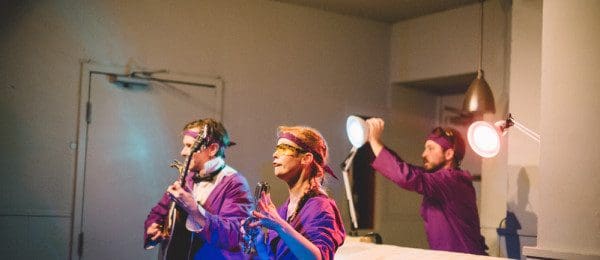Read Thea’s Reviews and Lorenzo’s Reviews of the NSTF.
 Graham Clark Reads the Phonebook
Graham Clark Reads the Phonebook
I loved comedian Graham Clark’s solo show at last summer’s Fringe Festival. So did everyone else, including Fringe head honcho Lucy Eveleigh. So Lucy invited him back for the Next Stage Festival. This, in theory, makes sense (especially considering they have the antechamber to fill). The trouble lies in the differences in the founding principles of Fringe and Next Stage. Fringe is for experimentation, new work, workshops, half-baked solo shows that get by mostly on the charisma of the performer; Graham Clark Reads the Phonebook would have made a perfectly good Fringe show (though it’s a little too half-baked to really compete with Clark’s fantastic I Think Therefore I’m Graham which actually did run at the Fringe). At least theoretically, Next Stage is a place where shows that may have already run at the Fringe (or elsewhere) take their next step (or Next Stage- get it?). It’s where the Drowsy Chaperone people could have workshopped the songs they added after their initial Fringe run (if the festival had existed back in 1999) or where Ins Choi could have tried out some changes to Kim’s Convenience before sending it to Soulpepper (if that show wasn’t already perfect). More and more, though, Next Stage is just becoming Winter Fringe with shows that are no more polished or thought out than what you can expect at the massive festival in July. I’m cool with Next Stage being just More Fringe, but then someone needs to change the name. Long story short, this is what I was thinking about during Graham Clark Reads the Phonebook because it was fun but not as fun as his Fringe show and it felt like a whole lot of problems could have been solved if this show had already been through a round of performances, been critiqued and revised, and was now at its Next Stage.
 Unbridled & Unstable
Unbridled & Unstable
Briana Templeton and Gwynne Phillips are a perfect pair. They balance each other’s energies, share a unique point of view, have complementary skills, and their timing and chemistry is so tight they appear to be able to read each others’ minds. This priceless quality is on bold display in their latest sketch show at Next Stage. Not every sketch is a hit (an audience participation horse race really misses the mark) but most are pretty great (a book club horror story; a surreal open house) and some are sheer genius (the opening sketch about foley artists; Templeton’s solo shot as a historical romance novelist). Some potential is left unfulfilled when no attempt is made to incorporate the equestrian theme into every sketch in some way (even just a passing reference would have made a decent recurring gag) but I’m not one to waste too much time wishing for more horses when there are serious dancebreaks to be enjoyed. Their plays may be more emotionally fulfilling but the Templeton Philharmonic’s sketch work is plenty on-point.
 Pulse
Pulse
This contemporary dance show set to classic Motown songs begins awkwardly (with a strained introduction plus lip-sync and audience-participation slow dance to “I Only Have Eyes For You”) and ends awkwardly (with yet more audience participation and a mandatory “get up on your feet” just in time to force a standing ovation) but what happens in the middle is pure joy (and a little pain, but the good kind with artistic value). The fun, familiar music keeps the show from slipping into the modern dance trap of self-seriousness that can be so hard for an audience to connect with while the sophisticated dance style(s) maintain the emotional resonance of the stories and keep most of the kitsch away. A diverse group of dancers with all kinds of body types makes a welcome change and some numbers are so indelible they’ll come to mind every time I hear the iconic songs (“Stand by Me” is particularly wonderful). If they would just leave the audience alone, this could be one of the best contemporary dance pieces of the year.
 Snack Music
Snack Music
Snack Music begins with the incredibly likeable Ingrid Hansen simply chatting with her audience. She explains how the piece developed from her desire to build impromptu communities in the lonely city. Hence the snacks (the vegan muffins are particularly great) and the story-sharing setup. Audience members volunteer (yes, volunteer; hear that, Pulse?!) to share a 1-2 minute story about the first time something happened to them. The audience at my performance offered up three stories, the first a fantastic and twisty tale involving fake nose piercings, doctor-administered cocaine and a community theatre production of A Christmas Carol; the second and third slightly less thrilling but excellently action-filled stories about lost teeth and stolen watches. The stories need to be action-filled because, after each story is told, Hansen and her partner Andrew G. Young improvise a puppeteered retelling set to an original score by Steven Chmilar. It’s a risky premise that leads to some great hits (the lost tooth was brilliantly carved out of a bell pepper representing the storyteller’s head) and a few misses, but it reveals major skill and excellent unspoken communication between the puppeteers. And it all leads to a fun sense of impromptu community which was, after all, the point.

